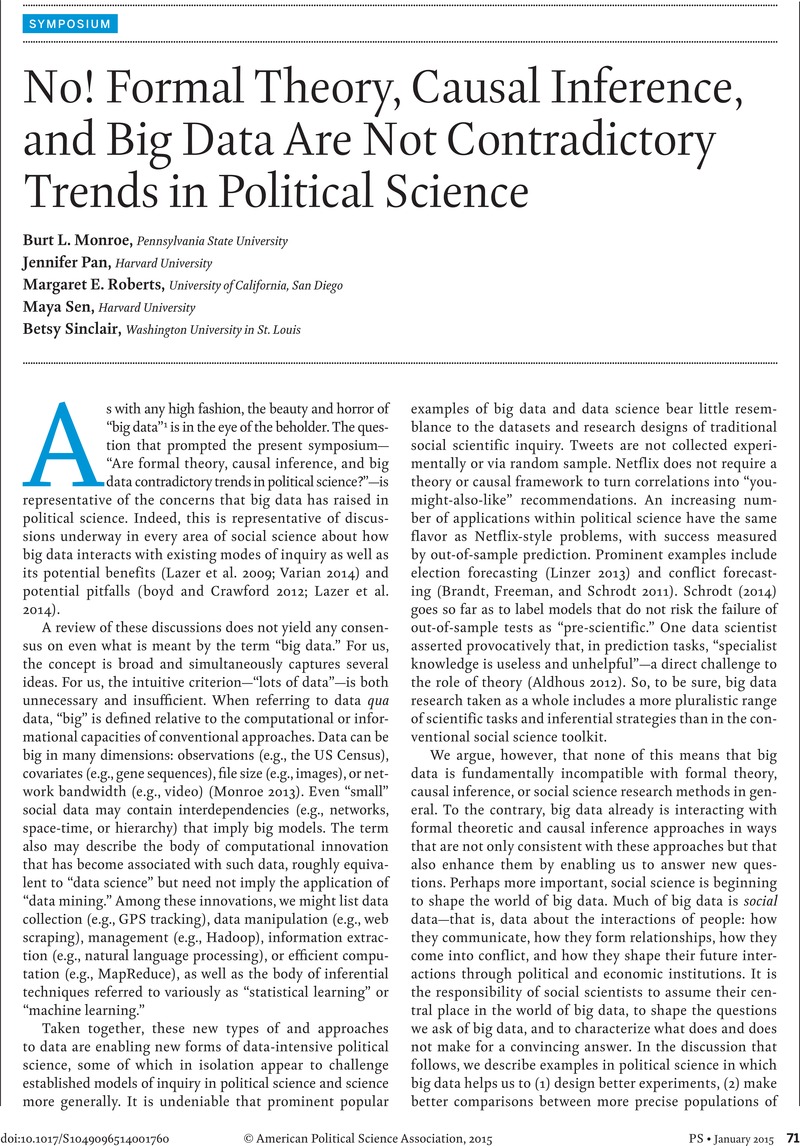Crossref Citations
This article has been cited by the following publications. This list is generated based on data provided by Crossref.
Monteith, Scott
Glenn, Tasha
Geddes, John
and
Bauer, Michael
2015.
Big data are coming to psychiatry: a general introduction.
International Journal of Bipolar Disorders,
Vol. 3,
Issue. 1,
Fariss, Christopher J.
Jones, Zachary M.
Linder, Fridolin
Crabtree, Charles
Biek, Megan A
Ross, Ana-Sophia M
and
Tsai, Michael
2015.
Human Rights Texts: Converting Human Rights Primary Source Documents into Data.
SSRN Electronic Journal,
Reith, Nicholas E.
Paxton, Pamela
and
Hughes, Melanie M.
2016.
Building Cross-National, Longitudinal Data Sets: Issues and Strategies for Implementation.
International Journal of Sociology,
Vol. 46,
Issue. 1,
p.
21.
Pang, Xun
2016.
Shared Challenges and Solutions: The Common Future of Comparative Politics and Quantitative Methodology.
Chinese Political Science Review,
Vol. 1,
Issue. 3,
p.
472.
Dalton, Russell J.
2016.
The Potential of Big Data for the Cross-National Study of Political Behavior.
International Journal of Sociology,
Vol. 46,
Issue. 1,
p.
8.
Margetts, Helen
2017.
The Data Science of Politics.
Political Studies Review,
Vol. 15,
Issue. 2,
p.
201.
Fong, Christian
Malhotra, Neil A.
and
Margalit, Yotam M.
2017.
Political Legacies.
SSRN Electronic Journal ,
Yang, Shuzhe
Quan-Haase, Anabel
and
Rannenberg, Kai
2017.
The changing public sphere on Twitter: Network structure, elites and topics of the #righttobeforgotten.
New Media & Society,
Vol. 19,
Issue. 12,
p.
1983.
Prufer, Jens
and
Prufer, Patricia
2018.
Data Science for Institutional and Organizational Economics.
SSRN Electronic Journal ,
van Atteveldt, Wouter
and
Peng, Tai-Quan
2018.
When Communication Meets Computation: Opportunities, Challenges, and Pitfalls in Computational Communication Science.
Communication Methods and Measures,
Vol. 12,
Issue. 2-3,
p.
81.
LIU, FRANK C. S.
2018.
Introduction to the Special Issue — Social Media and Inquiry into Political Change.
Issues & Studies,
Vol. 54,
Issue. 03,
p.
1802002.
Brantly, Aaron F.
2018.
When everything becomes intelligence: machine learning and the connected world.
Intelligence and National Security,
Vol. 33,
Issue. 4,
p.
562.
Stockmann, Daniela
2018.
Toward Area‐Smart Data Science: Critical Questions for Working With Big Data From China.
Policy & Internet,
Vol. 10,
Issue. 4,
p.
393.
Mijares, Víctor M.
2018.
Performance of the South American Defense Council Under Autonomy Pressures.
Latin American Policy,
Vol. 9,
Issue. 2,
p.
258.
Zhu, Jiangnan
Huang, Huang
and
Zhang, Dong
2019.
“Big Tigers, Big Data”: Learning Social Reactions to China's Anticorruption Campaign through Online Feedback.
Public Administration Review,
Vol. 79,
Issue. 4,
p.
500.
Algan, Yann
Murtin, Fabrice
Beasley, Elizabeth
Higa, Kazuhito
Senik, Claudia
and
Moat, Helen Susannah
2019.
Well-being through the lens of the internet.
PLOS ONE,
Vol. 14,
Issue. 1,
p.
e0209562.
Ozkan, Turgut
2019.
Criminology in the age of data explosion: New directions.
The Social Science Journal,
Vol. 56,
Issue. 2,
p.
208.
Prufer, Jens
and
Prufer, Patricia
2019.
Data Science for Entrepreneurship Research: Studying Demand Dynamics for Entrepreneurial Skills in the Netherlands.
SSRN Electronic Journal ,
Ceron, Andrea
Curini, Luigi
and
Iacus, Stefano M.
2019.
ISIS at Its Apogee: The Arabic Discourse on Twitter and What We Can Learn From That About ISIS Support and Foreign Fighters.
Sage Open,
Vol. 9,
Issue. 1,
Magkonis, Georgios
and
Jackson, Karen
2019.
Identifying Networks in Social Media: The case of #Grexit.
Networks and Spatial Economics,
Vol. 19,
Issue. 1,
p.
319.



